David Moody's Blog, page 57
July 29, 2015
Another sighting – HATER news imminent

I was in Greece this weekend and spotted this scrawled on a wall. Does this mean the long-teased HATER news is imminent?
Yes it is. The deal is signed and the ink is dry. An official announcement will be made here next week (I hope) and who knows – there may even be a second piece of HATER news to follow.
Thanks for your patience. More very soon. Things are about to get exciting.
Another sighting – HATER news imminent is a post from: David Moody - author of AUTUMN and HATER






July 21, 2015
An American Werewolf in London (and my regular Scream Magazine plug)
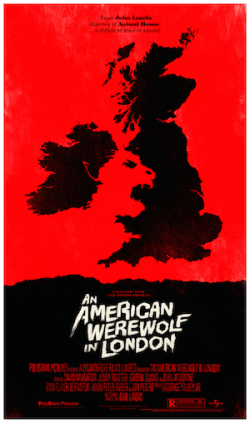 There are some films you can watch over and over and never get bored of. They’re timeless classics – as close to perfection as you can get. They’re the kind of films that make you recoil in terror whenever anyone dares mention remakes, because there’s absolutely no point. AN AMERICAN WEREWOLF IN LONDON
There are some films you can watch over and over and never get bored of. They’re timeless classics – as close to perfection as you can get. They’re the kind of films that make you recoil in terror whenever anyone dares mention remakes, because there’s absolutely no point. AN AMERICAN WEREWOLF IN LONDON is one of those films.
is one of those films.
I’m taking the opportunity to write about it now because a). it’s one of my absolute favourite movies and b). it’s heavily featured in the latest edition of SCREAM magazine. I’m sure you’ve already seen it (if not, why not?), but here’s a quick summary courtesy of IMDB and a trailer (which was produced for the bluray release a few years back, and which completely fails to capture the atmosphere of this most atmospheric film). Click the link below for my thoughts.
(By the way, check out the stunning Olly Moss poster I found online. It’s a thing of beauty.)
Two American college students are on a walking tour of Britain and are attacked by a werewolf. One is killed, the other is mauled. The werewolf is killed but reverts to its human form, and the local townspeople are unwilling to acknowledge its existence. The surviving student begins to have nightmares of hunting on four feet at first but then finds that his friend and other recent victims appear to him, demanding that he commit suicide to release them from their curse, being trapped between worlds because of their unnatural deaths.
There’s so much to love about AAWIL that I don’t know where to start. I’ll keep this recommendation brief because instead of reading this, you could watch the movie instead. If you’ve already seen it, you could watch it again. For a movie made more than thirty years ago, it’s barely aged.
I could talk about the excellent cast – , , Griffin Dunne and are all superb. I could talk about the wonderful soundtrack of moon-themed classic songs nestled against a classic score. I could talk about the black humour (because this is a very funny film in places). I could talk about the cinematography, ‘ expert direction… I could go on and on. As you can probably tell, AAWIL is one of my all-time favourites.
But no mention of the movie is complete without giving credit to make-up master , who won the first Academy Award for best make-up for his work here. In these days where CGI enhances everything, it’s hard to remember the impact of the key transformation scene on show here. Shot in full view in bright light, it’s an extraordinary achievement which truly raised the bar. I’ve embedded a clip below. Equally impressive is Griffin Dunne as Jack in various stages of decomposition.
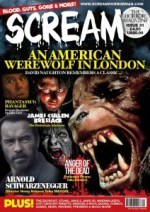 AAWIL is required viewing for all self-respecting horror fans, and that’s all there is to it.
AAWIL is required viewing for all self-respecting horror fans, and that’s all there is to it.
So now I’ve said my piece, may I respectfully draw your attention to the latest issue of SCREAM magazine? As usual, it’s full of great articles including a comprehensive 7 page retrospective on AAWIL and an interview with star David Naughton who looks back on the making of the film. There’s plenty more in this month’s issue too, including an interview with Henry Hobson, director of the film, RAVAGER.
Visit www.screamhorrormag.com, or pick up the magazine from any branch of HMV, Forbidden Planet, or any of the newsagents listed here. SCREAM is also available digitally as iSCREAM!
An American Werewolf in London (and my regular Scream Magazine plug) is a post from: David Moody - author of AUTUMN and HATER






July 13, 2015
The Mammoth Book of Sherlock Holmes Abroad – out in the US tomorrow
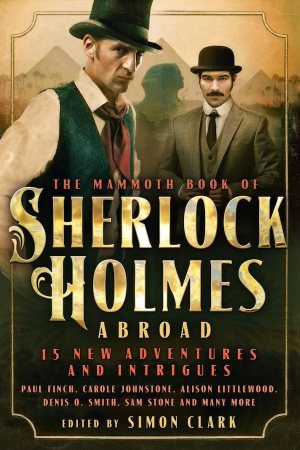 The title of this post says it all really. This anthology, edited by the great Simon Clark, hits the shelves in the US tomorrow. Published by Running Press, it’s available from all the usual outlets including Amazon
The title of this post says it all really. This anthology, edited by the great Simon Clark, hits the shelves in the US tomorrow. Published by Running Press, it’s available from all the usual outlets including Amazon , IndieBound and Barnes and Noble. Publishers Weekly gave the collection an excellent starred review which you can read below. Click here to remind yourself of the contents and contributors.
, IndieBound and Barnes and Noble. Publishers Weekly gave the collection an excellent starred review which you can read below. Click here to remind yourself of the contents and contributors.
Clark (The Night of the Triffids) has done a superior job in selecting the 15 original pastiches for this anthology, all of which remove Holmes from his Baker Street haunts to exercise his deduction skills in less familiar terrain. The standout, Paul Finch’s “The Monster of Hell’s Gate,” sends Holmes and Watson to East Africa, where the legendary Nandi bear, a creature familiar to cryptozoologists, has been decimating native workers on a new rail line. Finch blends suspense, atmosphere, and fair-play cluing so skillfully that many would welcome a longer Holmes story from his imagination. The always-reliable Denis O. Smith takes the duo to Russia in “The Adventure of the Colonel’s Daughter,” to clear a man caught literally red-handed at the scene of a murder. Clark’s own “The Climbing Man” confronts Holmes with an impossible crime in Mesopotamia. The consistent excellence makes this a better choice for Sherlockians than such similar volumes as “Sherlock Holmes in America” and “Sherlock Holmes: The American Years.”
The Mammoth Book of Sherlock Holmes Abroad – out in the US tomorrow is a post from: David Moody - author of AUTUMN and HATER
The post The Mammoth Book of Sherlock Holmes Abroad – out in the US tomorrow appeared first on David Moody - author of AUTUMN and HATER.






July 8, 2015
More HATER graffiti spotted…
Surely this must mean the HATER news I teased last month is coming soon?*

*It is. Not much longer to wait now.
More HATER graffiti spotted… is a post from: David Moody - author of AUTUMN and HATER
The post More HATER graffiti spotted… appeared first on David Moody - author of AUTUMN and HATER.






June 27, 2015
Infected Books at the Cardiff Independent Comic Expo

Thanks to everyone who turned out for the Cardiff Independent Comic Expo today. Another great event!
Infected Books at the Cardiff Independent Comic Expo is a post from: David Moody - author of AUTUMN and HATER
The post Infected Books at the Cardiff Independent Comic Expo appeared first on David Moody - author of AUTUMN and HATER.






Infected Books at the Cardiff Independentcomic Expo

Infected Books at the Cardiff Independentcomic Expo is a post from: David Moody - author of AUTUMN and HATER
The post Infected Books at the Cardiff Independentcomic Expo appeared first on David Moody - author of AUTUMN and HATER.






June 21, 2015
The Fly
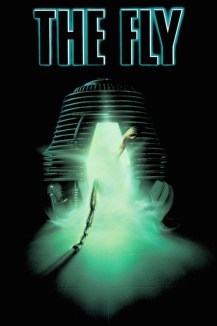 You’ve no doubt noticed the absence of much real news on this site recently. I’ve teased a few things (which will be announced very soon, I promise), but I’ve tried to make a point of adding more movie recommendations to help you remember I’m still here and still alive.
You’ve no doubt noticed the absence of much real news on this site recently. I’ve teased a few things (which will be announced very soon, I promise), but I’ve tried to make a point of adding more movie recommendations to help you remember I’m still here and still alive.
The classic horror movie education of my youngest kids continued last night with a screening of one of my favourite movies of all time – .
Now I know I rant against remakes frequently, but I’m also the first to admit there’s a time and a place for film ideas to be revisited (or reimagined, or rebooted, or whatever the trendy term of the day is). I talked about one a few weeks back – ’s 1979 remake of INVASION OF THE BODY SNATCHERS, and no doubt I’ll cover others here too.
Cronenberg’s THE FLY is a masterful reworking of the 1958 B movie starring and which was, in turn, an adaptation of a short story which had been published in PLAYBOY a year earlier. Here’s a brief summary of the Cronenberg version, followed by a trailer. My thoughts are after the cut.
By the way – the movie features a wonderful soundtrack from composer Howard Shore . The trailer below does not. Very little cheesy 1980’s synth pop appears in the finished film.
. The trailer below does not. Very little cheesy 1980’s synth pop appears in the finished film.
Seth Brundle, a brilliant but eccentric scientist, offers investigative journalist Veronica Quaife a scoop on his latest research in the field of matter transportation, which against all the expectations of the scientific establishment has proved successful. To a point. The machinery cannot yet transport organic matter. Brundle and Quaife’s burgeoning relationship helps him rethink the problem of ‘the flesh’. After successfully transporting a living creature, Brundle attempts to teleport himself, not realising a fly has enters the transmission booth with him. Brundle emerges a changed man.
So why is Cronenberg’s version of THE FLY a worthwhile second take on the story? The key reason, I believe, is that this is an excellent example of a film-maker taking an original concept and adding to it, rather than diluting. What we have here is the theme of Langelaan’s original story, updated both in front of the camera and behind the scenes. 1958 cinema audiences were aghast when our intrepid scientist teleported with the titular fly and assumed the creature’s head and arm, but in 1986 such an approach just wouldn’t have cut the mustard. Putting to one side the implausibility of teleportation for a moment, Cronenberg’s decision to splice man and insect at a molecular level makes far more sense (and also makes for far more gore). From a purely practical perspective too, it’s doubtful if the special effects experts of the fifties could have pulled off the level of slime-drooled grotesqueness on display in Cronenberg’s movie, and if they could, I doubt audiences of the time could have handled it.

The ground-breaking effects are a main talking point of the 1986 remake, but they’re not the be all and end all of the film. It was great to watch THE FLY again in high definition and a decent-sized screen, and to see that the practical gore effects still held up well. For a movie that’s almost thirty years old, that’s no mean feat. The metamorphosis and disintegration of ’s Seth Brundle is still shocking and startling in equal measure. Fingernails being peeled off, ears dropping off, bones breaking, vomiting over food, my daughters were well impressed (and that’s no mean feat).
For me, though, the true strengths of THE FLY lie elsewhere. First, huge credit must be given to Jeff Goldblum, Geena Davies and John Getz as the three leads. Between them they add a layer of plausibility and gravitas to what is an undeniably implausible, B-movie premise. It struck me last night that the whirlwind Brundle/ Quaife romance upon which the story hinges is almost as implausible as the DNA splicing of man and fly, but it’s written and performed so well that it’s easy to put such thoughts to one side and invest completely in the film.
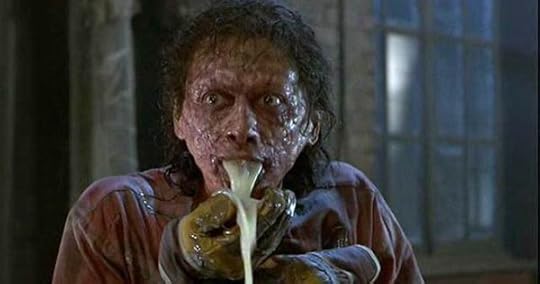
David Cronenberg is a master of body horror (if you’ve not seen SHIVERS , RABID
, RABID , THE BROOD
, THE BROOD , SCANNERS
, SCANNERS , VIDEODROME
, VIDEODROME , THE NAKED LUNCH
, THE NAKED LUNCH , EXISTENZ
, EXISTENZ or any of his other movies, you should stop reading this right now and sort that out), but in this movie more than any other of his, here the performances and the direction combine to great effect to invest you in the story and make you care. There’s a moment right at the end of the film which I’ll not spoil for you here, where Cronenberg and his cast manage to generate a huge amount of sympathy for a grotesque creature which was, until seconds earlier, about to willingly destroy his girlfriend and unborn child. That scene even elicited a whimper of sympathy from my seventeen year old (and if you knew her, you’d realise what an achievement that is).
or any of his other movies, you should stop reading this right now and sort that out), but in this movie more than any other of his, here the performances and the direction combine to great effect to invest you in the story and make you care. There’s a moment right at the end of the film which I’ll not spoil for you here, where Cronenberg and his cast manage to generate a huge amount of sympathy for a grotesque creature which was, until seconds earlier, about to willingly destroy his girlfriend and unborn child. That scene even elicited a whimper of sympathy from my seventeen year old (and if you knew her, you’d realise what an achievement that is).
As a writer, I’m fascinated with characters who don’t realise they’re wrong. Characters who one hundred per cent believe what they’re doing is right and correct, no matter what the impact on anyone else. The three main characters in THE FLY all fit that template to an extent. It’s a real treat how Cronenberg plays with their individual motives. The heroes become villains. The villain becomes a hero. In the end, does anyone really win?
Enough rambling. If you’ve not seen THE FLY, watch it now. You won’t regret it. It’s available on DVD and Bluray and through all the usual digital channels.
The Fly is a post from: David Moody - author of AUTUMN and HATER
The post The Fly appeared first on David Moody - author of AUTUMN and HATER.






June 16, 2015
Infected Books to be represented by Michael Preissl
 There’s a huge amount going on behind the scenes at Infected Books – lots of new projects being planned and opportunities being explored. I’ve said before, one of the keys aims of IB is to redress the business balance: being an author first and foremost, it’s important to me that the people who create books and films a). retain a high degree of control over their creative work and b). fairly share the benefit of the value of those creations. We’re working hard right now to explore new partnerships and outlets to make that happen, and I’m pleased to be able to announce one of those deals today.
There’s a huge amount going on behind the scenes at Infected Books – lots of new projects being planned and opportunities being explored. I’ve said before, one of the keys aims of IB is to redress the business balance: being an author first and foremost, it’s important to me that the people who create books and films a). retain a high degree of control over their creative work and b). fairly share the benefit of the value of those creations. We’re working hard right now to explore new partnerships and outlets to make that happen, and I’m pleased to be able to announce one of those deals today.
We’ve reached agreement with Michael Preissl, owner of Voodoo Press, for him to represent foreign language rights for Infected Books titles. You might already have seen the covers of the German-language editions of TRUST and GIRL IN THE BASEMENT . This is just the beginning!
. This is just the beginning!
I think this is a tremendously exciting development, and I’m looking forward to working closely with Michael as we spread the infection across the rest of the world.
Infected Books to be represented by Michael Preissl is a post from: David Moody - author of AUTUMN and HATER
The post Infected Books to be represented by Michael Preissl appeared first on David Moody - author of AUTUMN and HATER.






June 14, 2015
Seconds
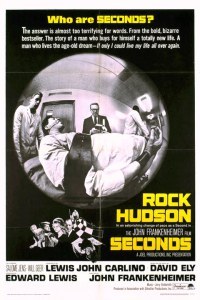 A relatively obscure movie recommendation for you this week. is a bizarre and chilling film which crashed and burned spectacularly at the box office when it was released in 1966. Watching it now, you can see why. It’s an intelligent and thought-provoking movie which was one of star ‘s personal favourites. He delivers a great performance as an old man with a new face – a role far removed from the easy-going romantic comedies he was well known for at the time. Synopsis and trailer follows, with a few thoughts after the cut:
A relatively obscure movie recommendation for you this week. is a bizarre and chilling film which crashed and burned spectacularly at the box office when it was released in 1966. Watching it now, you can see why. It’s an intelligent and thought-provoking movie which was one of star ‘s personal favourites. He delivers a great performance as an old man with a new face – a role far removed from the easy-going romantic comedies he was well known for at the time. Synopsis and trailer follows, with a few thoughts after the cut:
Banker Arthur Hamilton (John Randolph) gets a call one day from a friend he thought was dead. It turns out that the friend is not a ghost, but was simply faking all along, and was placed into a new existence by a company who can give you a completely new face and life. Hamilton decides to undergo the procedure himself and becomes Tony Wilson (Rock Hudson), an artist who lives in Malibu. He is given a manservant to help him adjust but soon finds that adjusting will be the least of his worries.
Based on a novel by David Ely , SECONDS feels ahead of its time, and maybe that’s one of the reasons why it didn’t find much of an audience on first release. It has the air and mystery of a TWILIGHT ZONE
, SECONDS feels ahead of its time, and maybe that’s one of the reasons why it didn’t find much of an audience on first release. It has the air and mystery of a TWILIGHT ZONE episode, but its feature length allows its themes and characters to be explored with greater depth. Frankenheimer’s direction is masterful, with a freely moving camera which adds to the sense of disorientation the audience feels. It’s little surprise that the movie’s cinematographer, James Wong Howe, was nominated for an Academy Award for his work here.
episode, but its feature length allows its themes and characters to be explored with greater depth. Frankenheimer’s direction is masterful, with a freely moving camera which adds to the sense of disorientation the audience feels. It’s little surprise that the movie’s cinematographer, James Wong Howe, was nominated for an Academy Award for his work here.
The real revelation here, though, is Rock Hudson. Fighting against type, he delivers a superb performance as the man with a new face who’s forced to consider his past, present and future from a unique perspective.
This post is short and sweet, but I really don’t want to say too much more about SECONDS for fear of spoiling it for those who haven’t seen it. The movie was hard to find for many years, but was re-released on bluray and DVD by the Criterion Collection in 2013. It’s fair to say that, after a superb opening segment, the film sags a little during the middle act, but it soon picks up speed again towards the end. The final startling scenes, once watched, will stay in your memory for a long time after viewing.
SECONDS is highly recommended.
Seconds is a post from: David Moody - author of AUTUMN and HATER
The post Seconds appeared first on David Moody - author of AUTUMN and HATER.






June 11, 2015
Dog Blood
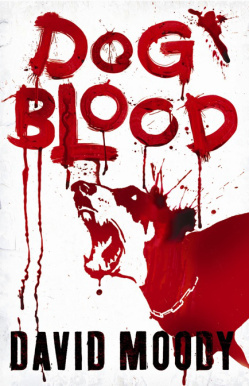 I know I’m being really annoying at the moment, and I apologise. I want to talk, but I can’t. I also can’t help wanting to torment you a little more…
I know I’m being really annoying at the moment, and I apologise. I want to talk, but I can’t. I also can’t help wanting to torment you a little more…
Hard to believe, but DOG BLOOD was five years old this week.
was five years old this week.
DOG BLOOD was the first novel I wrote under contract, and that meant it was the first book not to have been published through Infected Books first. As a result, writing it was a very different experience. Previously I’d worked in isolation; now I found myself crafting the book under the auspices of two different editors – one in London and one in New York, both with different approaches. It took longer to finish the novel than expected, but the end result was a story I was (and still am) hugely proud of.
was the first novel I wrote under contract, and that meant it was the first book not to have been published through Infected Books first. As a result, writing it was a very different experience. Previously I’d worked in isolation; now I found myself crafting the book under the auspices of two different editors – one in London and one in New York, both with different approaches. It took longer to finish the novel than expected, but the end result was a story I was (and still am) hugely proud of.
The book picks up a couple of months after the end of HATER . Here’s the synopsis:
. Here’s the synopsis:
The world has suffered a catastrophe of unknown cause, dividing humankind into two: the Haters and the Unchanged. Each group believes the other to be the enemy; each group is fighting for survival. Only by working together can the enemy – whoever that enemy is – be defeated. There are no other choices.
Danny McCoyne has managed to break free, and after days of indiscriminate fighting and killing, he is determined to make his way home, to recalim the only thing of any value to him in this strange new world: his daughter Ellis. Unlike his wife and son, Ellis is like him, and he knows, in his heart of hearts, that she is not dead. His dearest wish is for Ellis to be fighting for the world at his side – but Danny soon discovers his daughter is worth far more than just another fighting body. Others like him have discovered that children are absolutely vital to the cause. They are strong, small, fast, and they have no inhibitions. They are pure Haters…
And today’s unnecessary tease… ever wondered what happened in the months between HATER and DOG BLOOD
and DOG BLOOD ? Ever wondered how things got so bad so quickly in the Unchanged refugee camp? Ever wondered who was really in control there?
? Ever wondered how things got so bad so quickly in the Unchanged refugee camp? Ever wondered who was really in control there?
I have.
More soon.
Dog Blood is a post from: David Moody - author of AUTUMN and HATER
The post Dog Blood appeared first on David Moody - author of AUTUMN and HATER.










